Fluid Flow Behavior in Nanometer-Scale Pores and Its Impact on Shale Oil Recovery Efficiency
Abstract
:1. Introduction
2. Nanopore Flow Model Construction
2.1. Nanopore Capillary Imbibition Model
2.2. Slip Length and Boundary Conditions
3. Single-Factor Nanopore Flow Analysis
3.1. Pore Size Impact on Nanopore Flow
3.2. Viscosity Ratio Impact on Nanopore Flow
3.3. Wettability Impact on Nanopore Flow
3.4. Pressure Impact on Nanopore Flow
4. Multi-Factor Nanopore Flow Analysis
4.1. Pore Size and Contact Angle Synergy
4.2. Pressure and Contact Angle Synergy
4.3. Pressure, Pore Size, and Contact Angle Synergy
5. Conclusions
Author Contributions
Funding
Data Availability Statement
Acknowledgments
Conflicts of Interest
References
- Zang, X.; Pang, J.; Ma, L.; Zhu, Z. Exploration of the Exploitation Potential of Continental Shale Oil in China. Chem. Ind. Manag. 2024, 5, 77–79. [Google Scholar]
- Li, Y.; Zhao, Q.; Lu, Q.; Xue, Z.; Cao, X.; Liu, Z. Evaluation Techniques and Practices for the Development of Continental Shale Oil in China. Pet. Explor. Dev. 2022, 49, 955–964. [Google Scholar] [CrossRef]
- Liu, D. Study on the Mechanism of Micro-Imbibition of Fracturing Fluid and “Soaking Well” for Enhanced Production; China University of Petroleum: Beijing, China, 2017; p. 109. [Google Scholar]
- Sun, Q.; Wang, W.; Su, Y.; Xun, J.; Guo, X.; Li, G. Characteristics of Microscopic Pore Oil Mobilization during the Imbibition of Fracturing Fluid in Shale Reservoirs. J. Cent. South Univ. (Nat. Sci. Ed.) 2022, 53, 3311–3322. [Google Scholar]
- Wang, Q.; Zhao, J.; Hu, Y.; Ren, L.; Zhao, C. Optimization Method for Shut-In Time after Hydraulic Fracturing in Shale Oil Reservoirs. Pet. Explor. Dev. 2022, 49, 586–596. [Google Scholar] [CrossRef]
- Wang, X. Optimization of Shut-In Time after Fracturing Based on Imbibition Experiments in Tight Reservoirs; Northeast Petroleum University: Daqing, China, 2022; p. 71. [Google Scholar]
- Nagayama, G.; Cheng, P. Effects of interface wettability on microscale flow by molecular dynamics simulation. Int. J. Heat Mass Transf. 2003, 47, 501–513. [Google Scholar] [CrossRef]
- Coasne, B.; Jain, S.K.; Gubbins, K.E. Adsorption, structure and dynamics of fluids in ordered and disordered models of porous carbons. Mol. Phys. 2006, 104, 3491–3499. [Google Scholar] [CrossRef]
- Chen, X.; Cao, G.; Han, A.; Punyamurtula, V.K.; Liu, L.; Culligan, P.J.; Kim, T.; Qiao, Y. Nanoscale Fluid Transport: Size and Rate Effects. Nano Lett. 2008, 8, 2988–2992. [Google Scholar] [CrossRef] [PubMed]
- Kucaba-Pietal, A.; Kordos, A. Water nanovortices formation in 2D open type long nanocavities. Molecular dynamics study. J. Mol. Liq. 2018, 249, 160–168. [Google Scholar] [CrossRef]
- Falk, K.; Coasne, B.; Pellenq, R.; Ulm, F.-J.; Bocquet, L. Subcontinuum mass transport of condensed hydrocarbons in nanoporous media. Nat. Commun. 2015, 6, 6949. [Google Scholar] [CrossRef] [PubMed]
- Jin, B.; Bi, R.; Nasrabadi, H. Molecular simulation of the pore size distribution effect on phase behavior of methane confined in nanopores. Fluid Phase Equilibria 2017, 452, 94–102. [Google Scholar] [CrossRef]
- Liu, B.; Qi, C.; Zhao, X.; Teng, G.; Zhao, L.; Zheng, H.; Zhan, K.; Shi, J. Nanoscale Two-Phase Flow of Methane and Water in Shale Inorganic Matrix. J. Phys. Chem. C 2018, 122, 26671–26679. [Google Scholar] [CrossRef]
- Yang, Q.; Jin, B.; Banerjee, D.; Nasrabadi, H. Direct visualization and molecular simulation of dewpoint pressure of a confined fluid in sub-10 nm slit pores. Fuel 2019, 235, 1216–1223. [Google Scholar] [CrossRef]
- Fang, T. Molecular Simulation Study of the Microscopic Mechanism of CO₂ Flooding in Tight Reservoirs; China University of Petroleum (East China): Qingdao, China, 2020. [Google Scholar]
- Zhang, D.; Tang, H.; Zhang, X.; Ranjith, P.; Perera, M. Molecular simulation of methane adsorption in nanoscale rough slits. J. Nat. Gas Sci. Eng. 2022, 102, 104608. [Google Scholar] [CrossRef]
- Chen, J.; Ma, N.; Guo, J.; Zhao, J.; Wei, N. Molecular Simulation of Adsorption and Transport of Shale Gas in Rough Nanopores. J. At. Mol. Phys. 2024, 41, 67–74. [Google Scholar]
- Neto, C.; Evans, D.R.; Bonaccurso, E.; Butt, H.-J.; Craig, V.S.J. Boundary slip in Newtonian liquids: A review of experimental studies. Rep. Prog. Phys. 2005, 68, 2859–2897. [Google Scholar] [CrossRef]

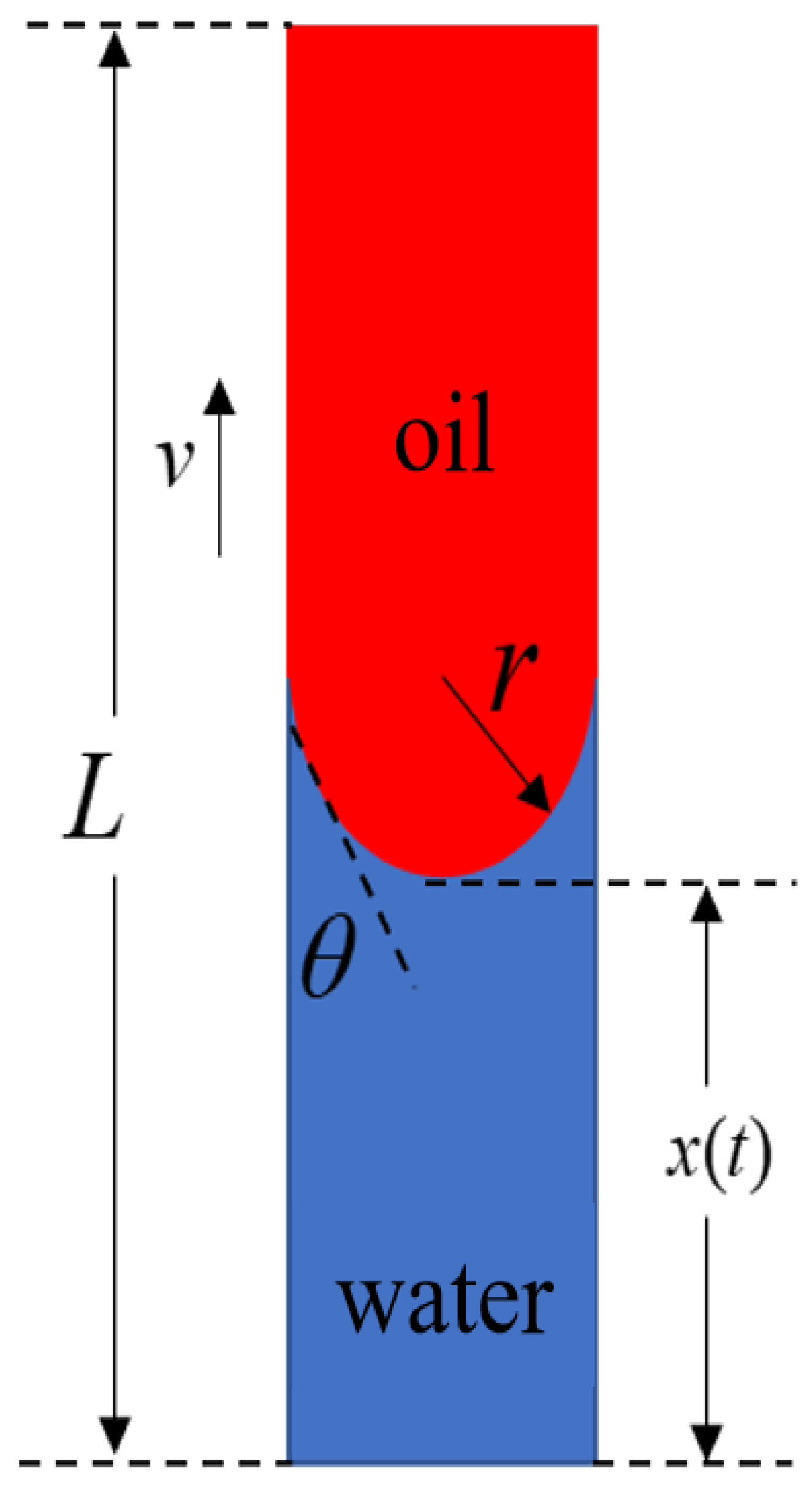

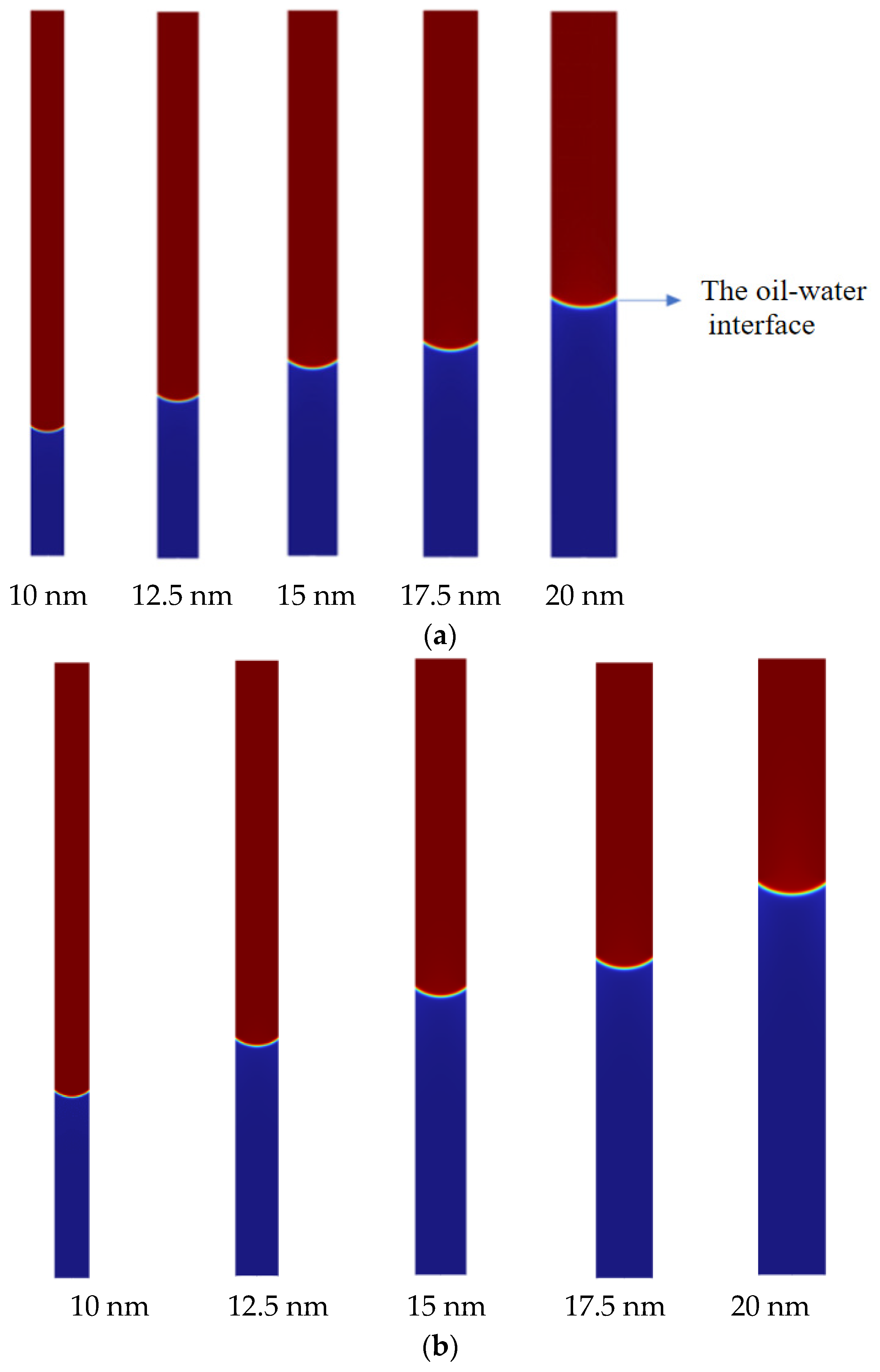

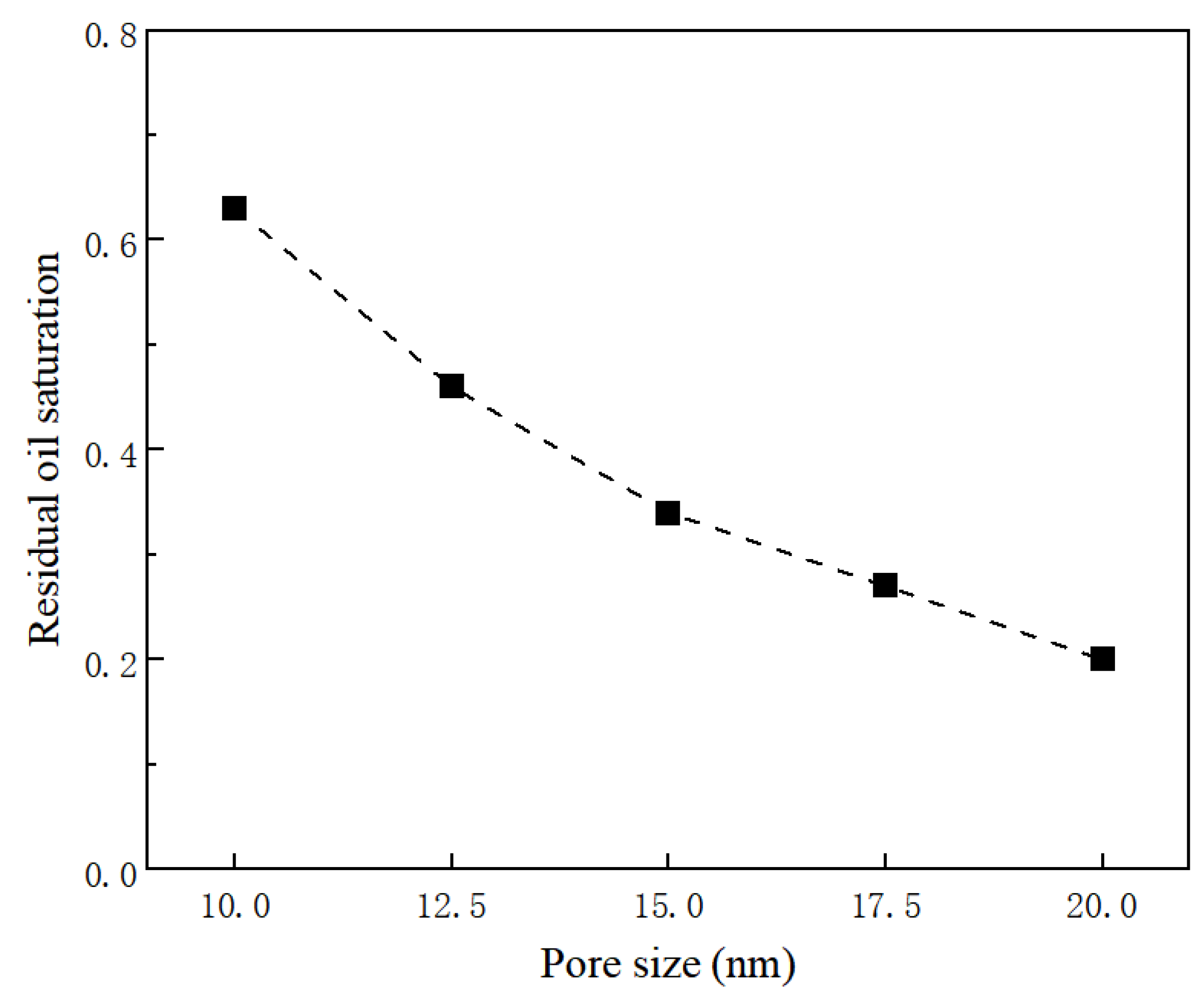




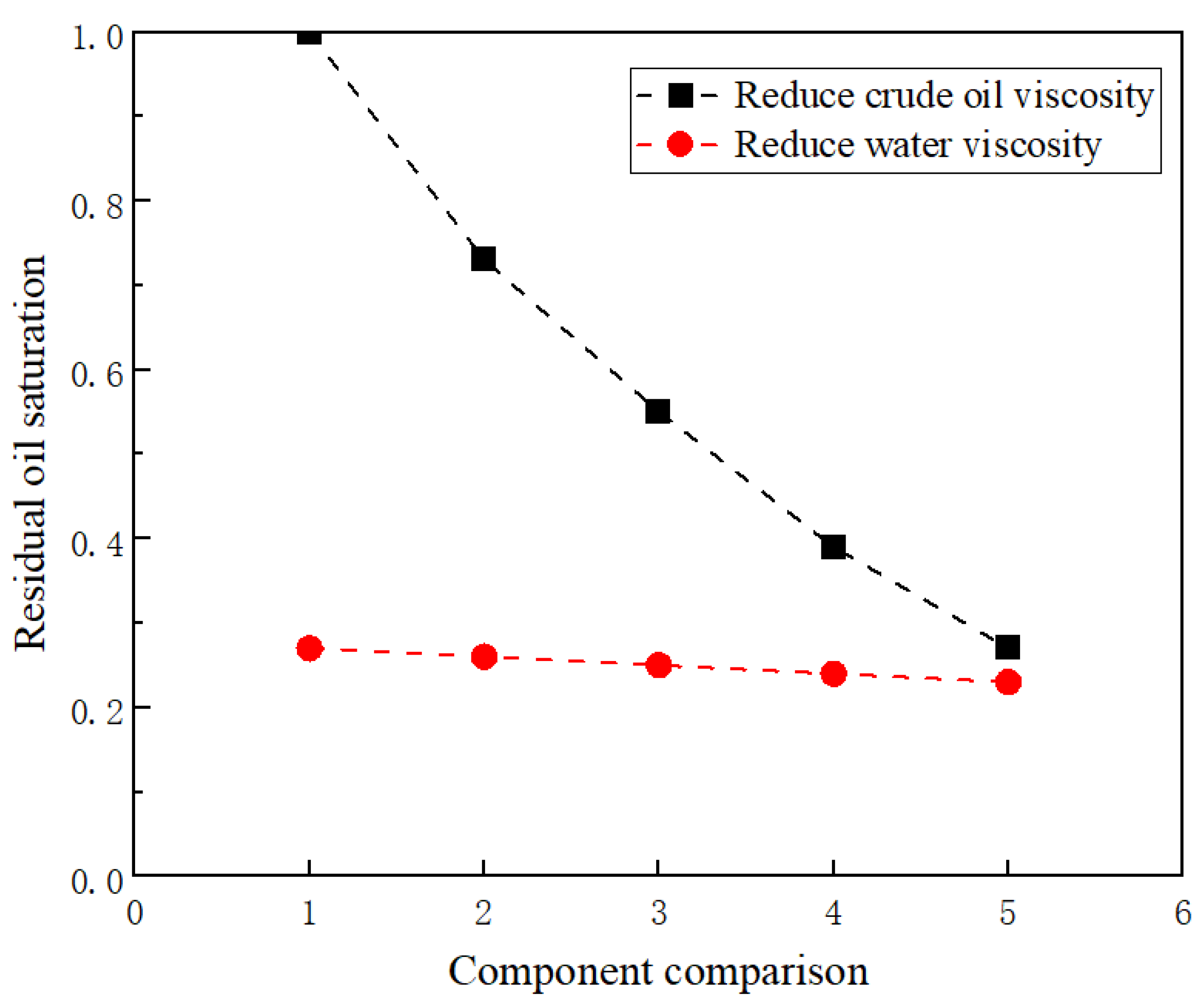
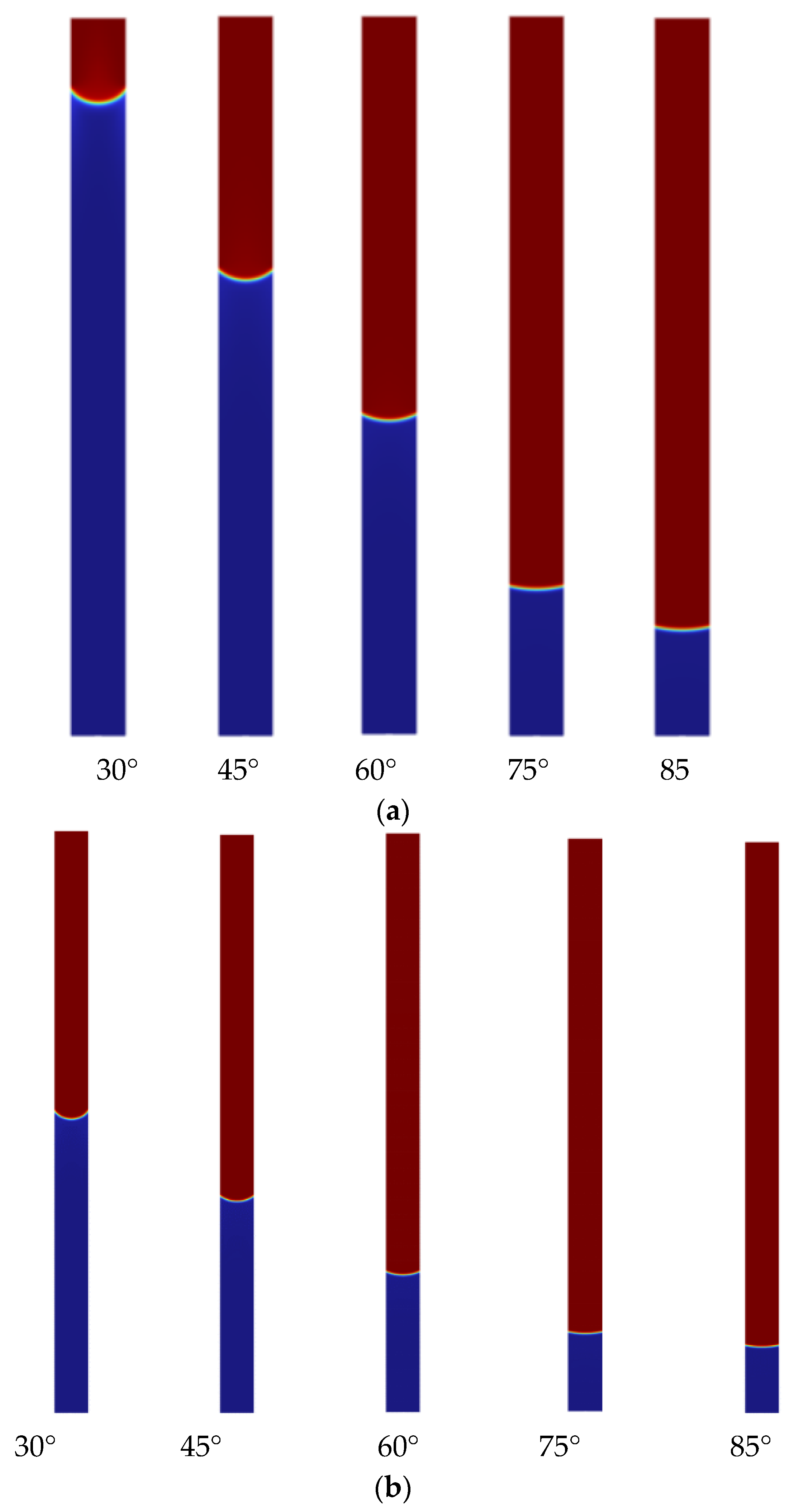
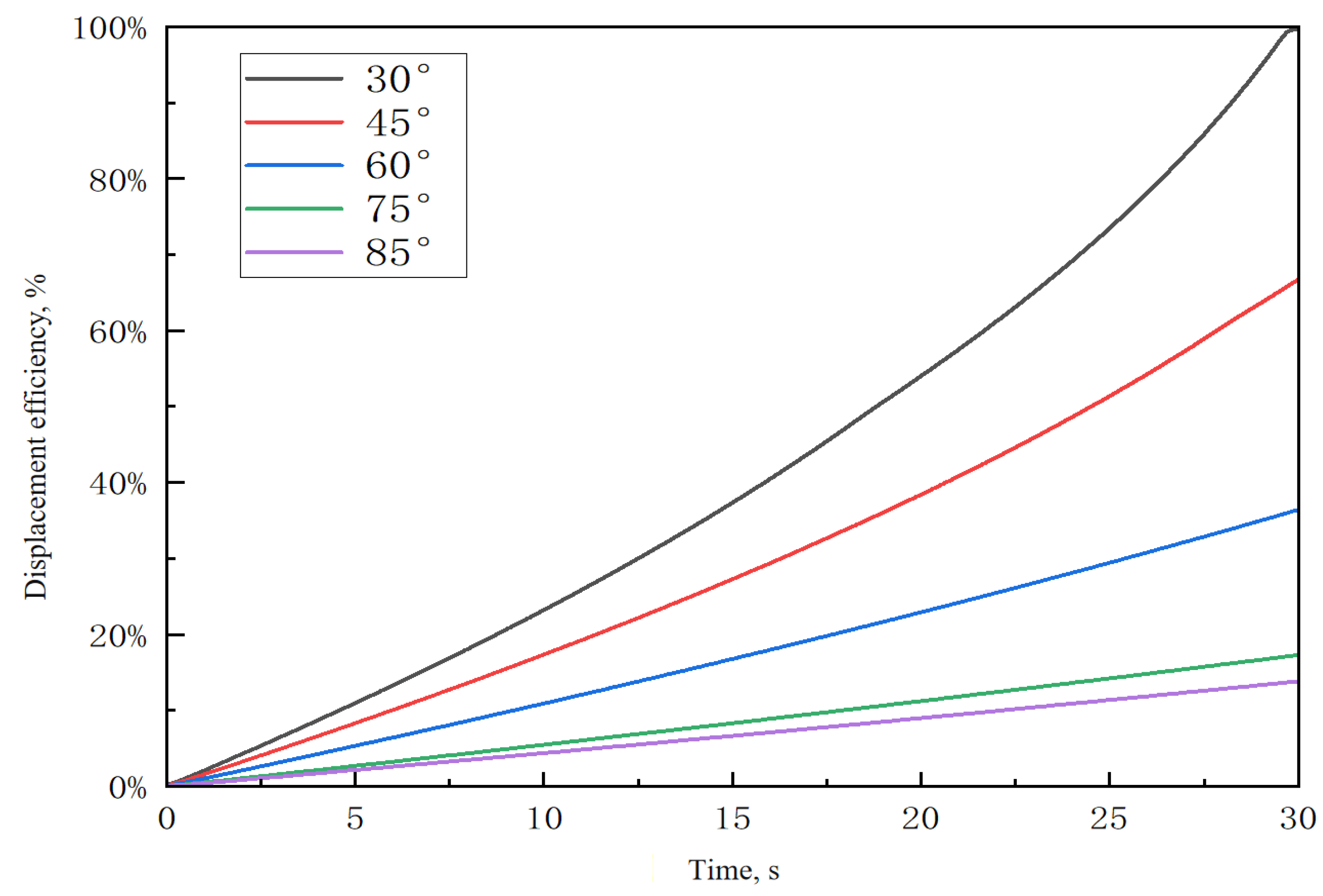
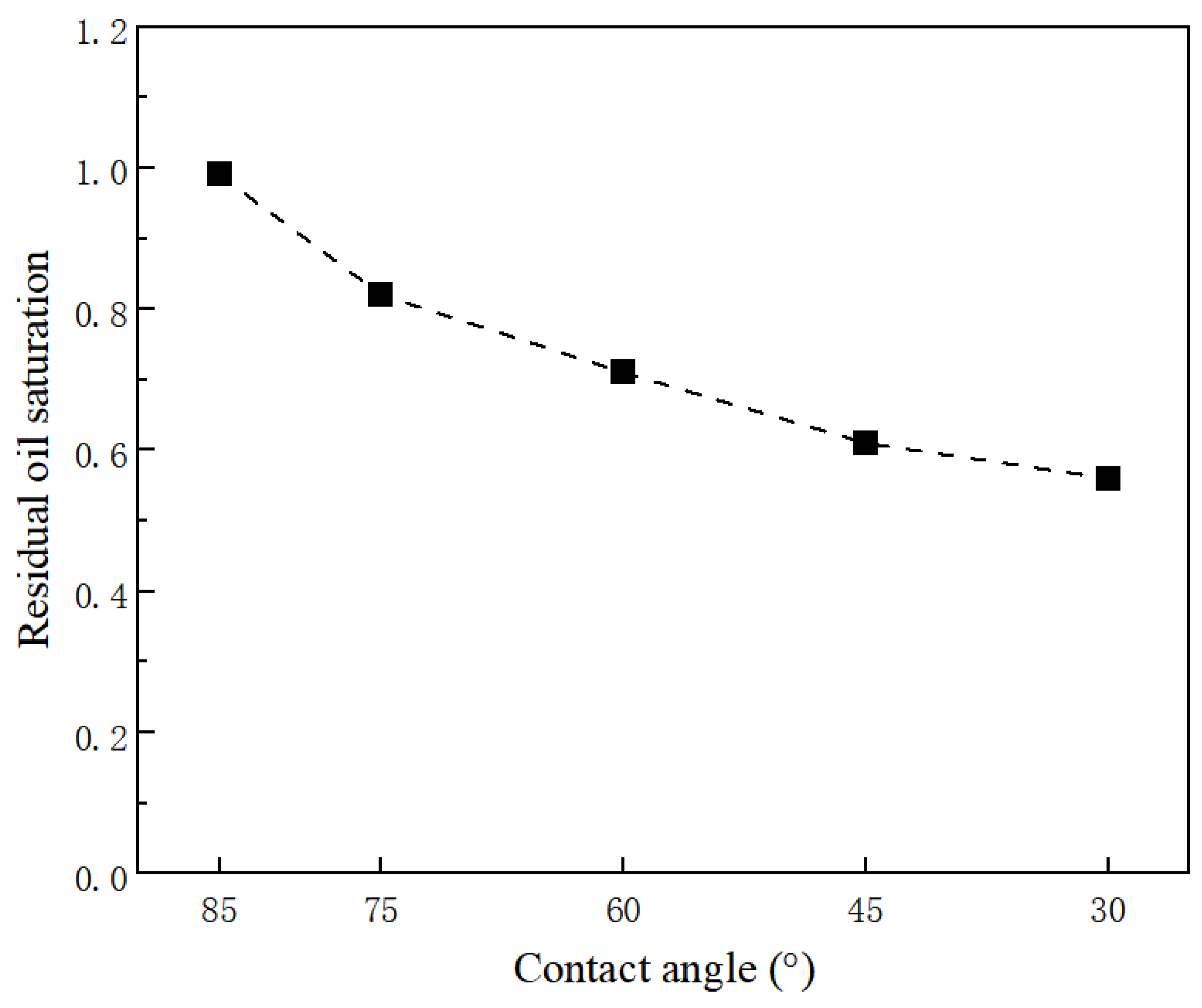
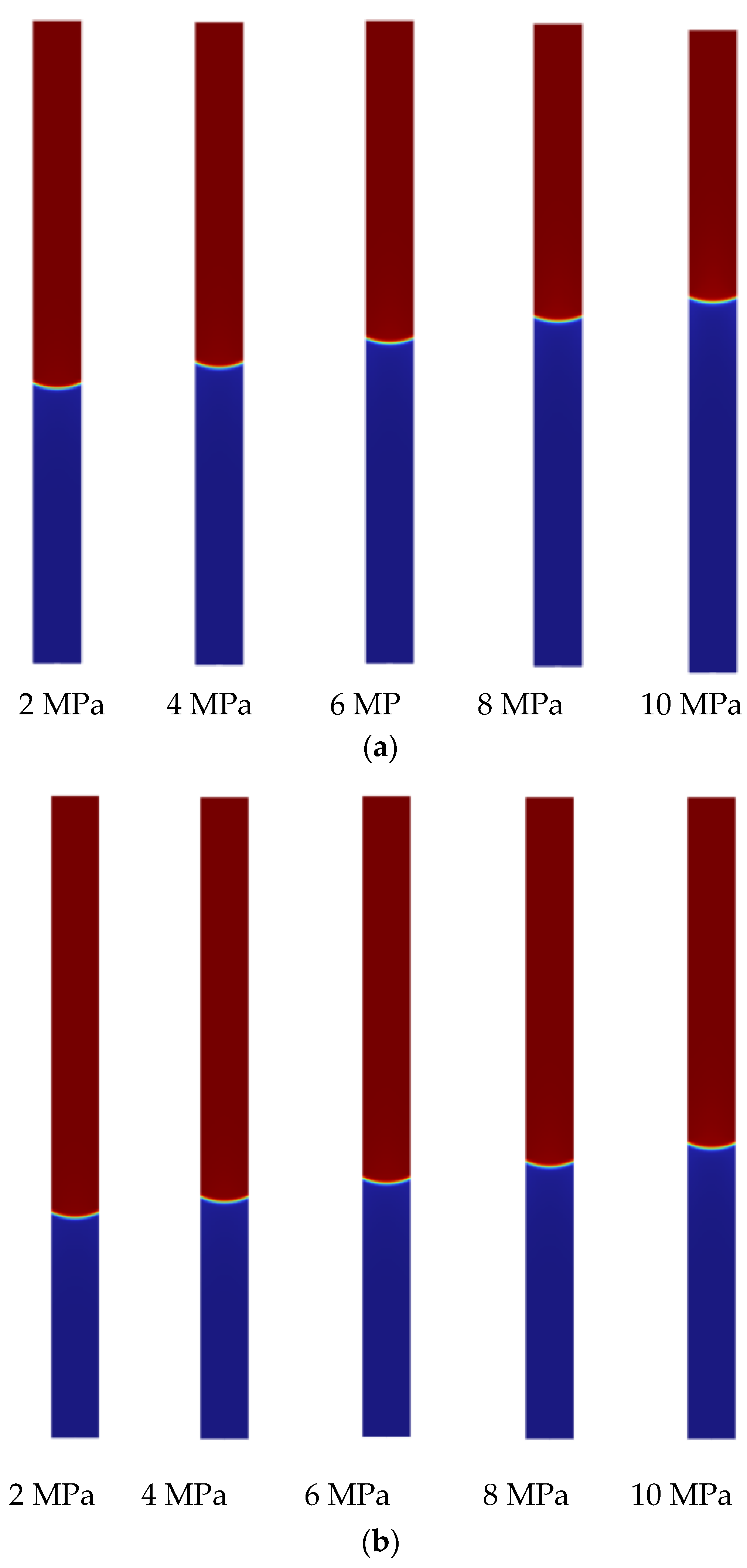






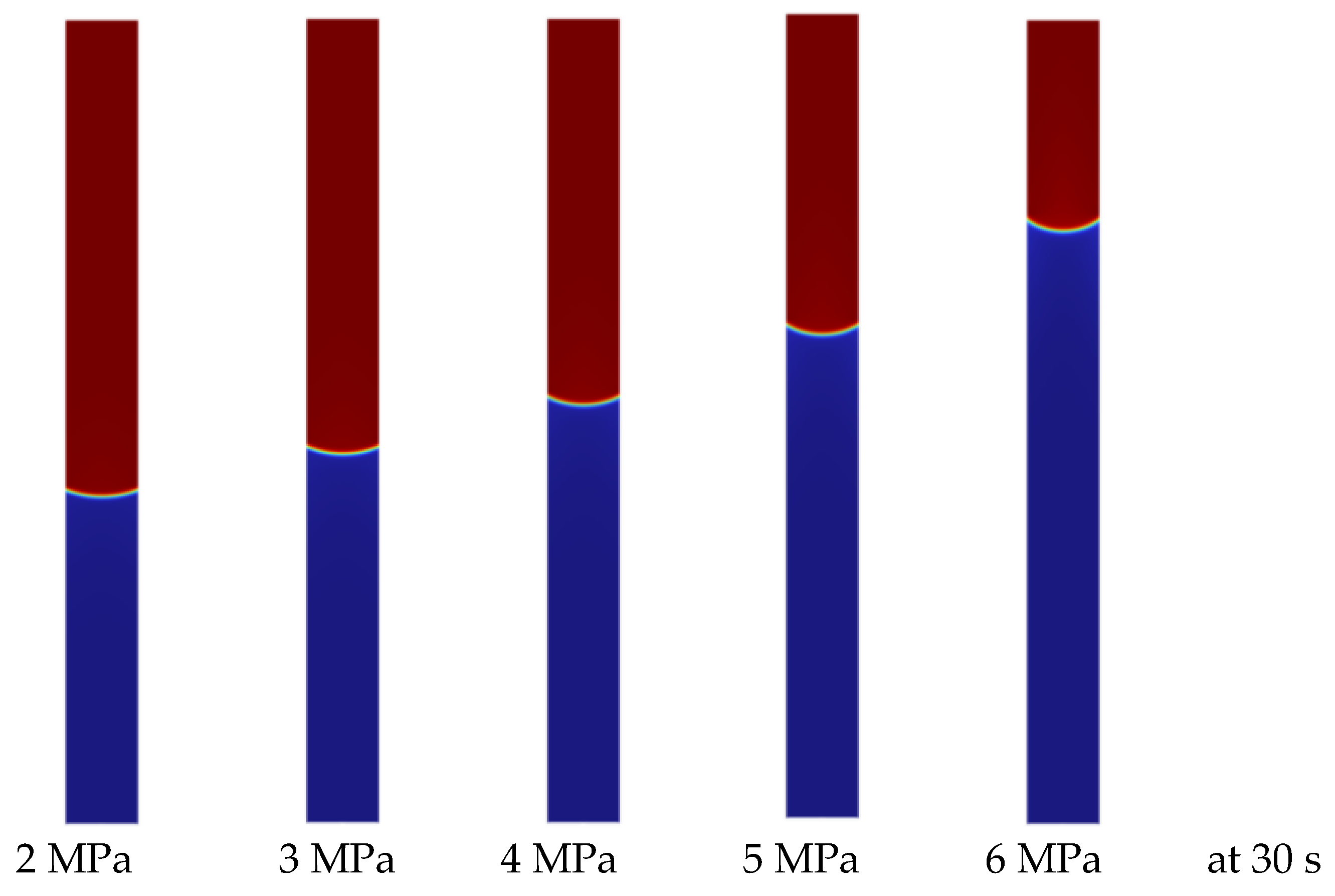
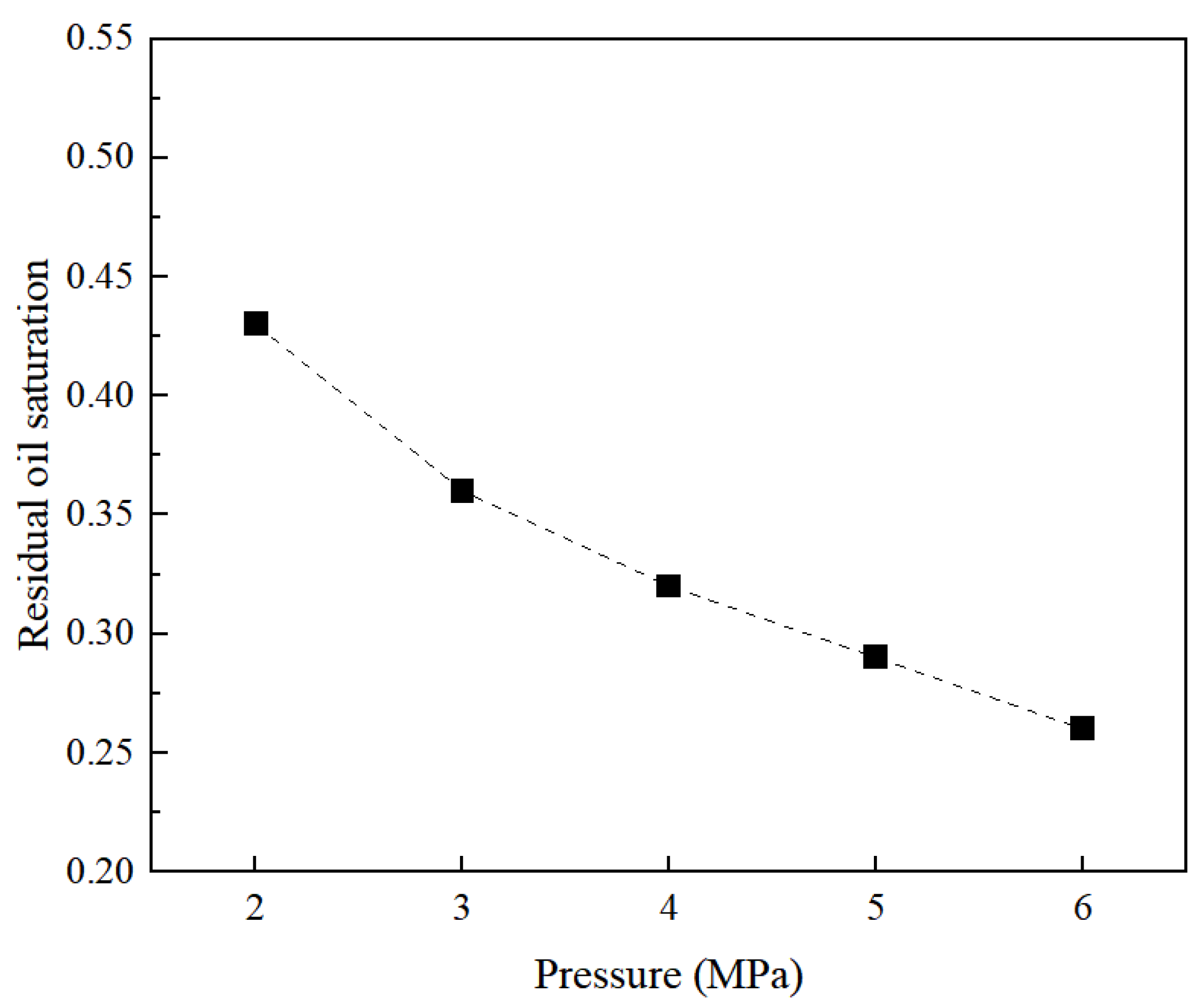
| Scheme | Viscosity of Water (mPa·s) | Oil Viscosity (mPa·s) | Oil Viscosity (mPa·s) | Water Viscosity (mPa·s) |
|---|---|---|---|---|
| 1 | 1 | 10 | 10 | 8 |
| 2 | 8 | 5 | ||
| 3 | 5 | 3 | ||
| 4 | 3 | 2 | ||
| 5 | 2 | 1 |
| Inlet Pressure /MPa | Porosity/% | Poisson’s Ratio | Effective Stress /MPa | Initial Pressure /MPa | Young’s Modulus /MPa | Contact Angle/° |
|---|---|---|---|---|---|---|
| 2 | 0.1 | 0.15 | 0.5 | 2 | 5 | 41° |
| 3 | 0.1 | 0.15 | 0.5 | 2 | 5 | 48.38° |
| 4 | 0.1 | 0.15 | 0.5 | 2 | 5 | 53.71° |
| 5 | 0.1 | 0.15 | 0.5 | 2 | 5 | 57.81° |
| 6 | 0.1 | 0.15 | 0.5 | 2 | 5 | 61.5° |
Disclaimer/Publisher’s Note: The statements, opinions and data contained in all publications are solely those of the individual author(s) and contributor(s) and not of MDPI and/or the editor(s). MDPI and/or the editor(s) disclaim responsibility for any injury to people or property resulting from any ideas, methods, instructions or products referred to in the content. |
© 2024 by the authors. Licensee MDPI, Basel, Switzerland. This article is an open access article distributed under the terms and conditions of the Creative Commons Attribution (CC BY) license (https://creativecommons.org/licenses/by/4.0/).
Share and Cite
Dou, X.; Qian, M.; Zhao, X.; Wang, A.; Lei, Z.; Guo, E.; Chen, Y. Fluid Flow Behavior in Nanometer-Scale Pores and Its Impact on Shale Oil Recovery Efficiency. Energies 2024, 17, 4677. https://doi.org/10.3390/en17184677
Dou X, Qian M, Zhao X, Wang A, Lei Z, Guo E, Chen Y. Fluid Flow Behavior in Nanometer-Scale Pores and Its Impact on Shale Oil Recovery Efficiency. Energies. 2024; 17(18):4677. https://doi.org/10.3390/en17184677
Chicago/Turabian StyleDou, Xiangji, Menxing Qian, Xinli Zhao, An Wang, Zhengdong Lei, Erpeng Guo, and Yufei Chen. 2024. "Fluid Flow Behavior in Nanometer-Scale Pores and Its Impact on Shale Oil Recovery Efficiency" Energies 17, no. 18: 4677. https://doi.org/10.3390/en17184677






